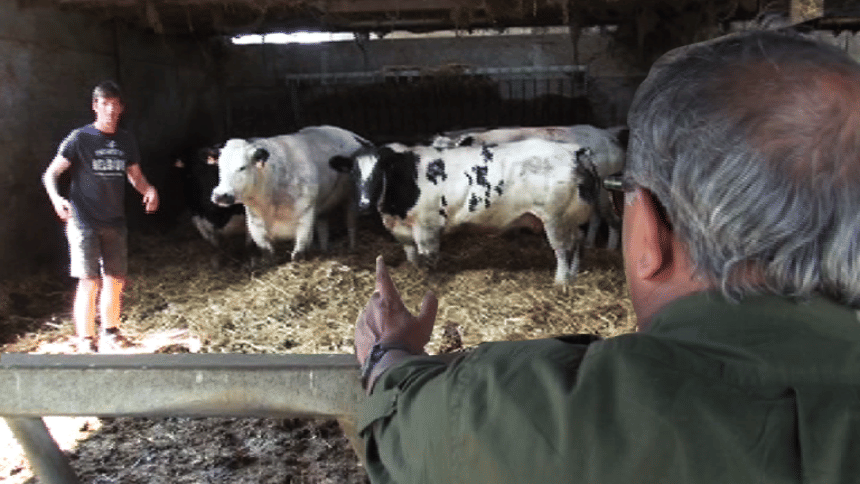Belgian Blue can meet demand for cow meat

The day was the 7th of June, 2016 when I arrived in the country of glass. But glass was not my concern. I wanted to see something related to my work. I will try to pass on to the readers my curiosity for visiting the 'glass-country'.
Rightly guessed, I was visiting Belgium, located in Western Europe, known for its medieval towns, renaissance architecture and of course, famous for glass. But Belgium is also famous for a cattle breed known as Belgian Blue, also called White Blue, Blue White and so on.
It is a meat cow and weighs an average of 800 kilograms, five times more than our Bangladeshi breed. The bulls may go up to 1,100 to 1,250 kilograms.
I rode from port city Ghent to reach the calm and beautiful municipality of Avelgem, located in the Belgian province of West Flanders, to see something they call the monster. My friends working for CID Lines (supplier of hygiene solutions) took me into the stunning nature of Avelgem.
A white blue cow farmer named Gerth was there to welcome me. I went right into the farm and saw the seventh wonder of my life, the Belgian Blue.
The cattle breed originated in the central and upper Belgium. The real breakthrough came in the 1960s with the development of the great double muscling characteristics. As a consequence of adept selection, the Belgian local breed, as we know it today, was born.
It is a large animal with prominent muscles; its back is absolutely straight and has strong legs. Despite such a large stature, it is a little afraid of people. The breed is known for its quiet nature.
In three years, its weight can go up to 750 kilograms. All of Gerth's calves in the farm are caesarean. A cow can go through this procedure six times in a life cycle. A one-day calf weighs up to 65 kilograms and drinks five litres of powder milk. Right before artificial insemination (AI), they weigh around 350 to 450 kilograms.
There are private organisations that deliver the quality frozen semen. Gerth says, after three months, the calves are given nutrients and grains -- that is why they keep on growing steadily and fast. During my visit to the Netherlands last year, I saw that Wageningen University has quite the same facility and research for ensuring quality cattle feed for their perfect growth. A farm named De Marke is working on cattle feed and rearing under the university there. It is almost the same as in China's Shandong province that I witnessed earlier this year.
"It apparently seems antibiotics were used for the growth, but in reality, it is not," says Robin Franzon, daily technical support officer, working at the CID Lines. "It happens due to mutation of the myostatin gene."
The huge muscles of the breed are known as 'double muscling'. It outclasses all other breeds. Extensive research shows pure Belgian Blues bear two types of myostatin genes.
Eid-ul-Azha is just around the corner for us. According to the livestock department of our country, we have more than 44 lakh cows ready for slaughtering, while there are around 7.5 lakh goats and sheep as well. Still, we see cows coming in from our neighbouring country. We still depend on others for cow meat.
As a modern breed, Belgian Blue is exceptional for short gestation periods, structure and mobility, high food efficiency for fattening, facility for cross-breeding calving, unique muscles, and also ease of calving. These cattle are sturdy and do well in most climates. It can stay strong in chilly winter to hot and humid temperatures.
Just a reminder, to increase meat production in our country, the livestock department began rearing the American beef cattle 'Brahman' during 2008-10. Rearing is being carried out in 80 upazilas at the farm level. The result seems to be optimistic.
On an average, we get 200 kilograms of meat from a cow. It varies from 60 kilograms to a maximum of 360 kilograms. Meanwhile, the Belgian Blue can produce a minimum of 800 kilograms. This surpasses all other varieties.
So, we can say this breed can easily meet the demand for meat, if it is introduced in Bangladesh. The livestock department can also compare the results of this variety with 'Brahman' and keep the best for future.
If we can ensure that the breed reaches the farm level, we could easily meet local demand and there will certainly be a drastic change in our country. With the right intervention of research and field level technology, we surely can achieve this. That is what I firmly believe in.
The writer is the director and head of news at Channel i and can be reached at [email protected].

 For all latest news, follow The Daily Star's Google News channel.
For all latest news, follow The Daily Star's Google News channel. 



Comments